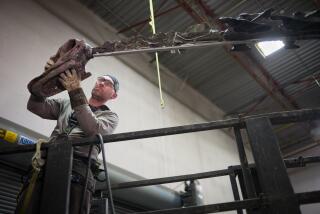Houston: See the lovely bones at new paleontology hall
- Share via
Are you an armchair dinosaur hunter who will be in Houston? Here’s a target-rich opportunity: Carve out at least a couple of hours to prowl the Houston Museum of Natural Science‘s dramatic new paleontology hall.
Thanks to the latest technological wizardry -- such as computer-generated animation that creates virtual aquariums -- the museum manages to achieve the intimacy of an art gallery with ancient fossils both massive and tiny.
A key is the way designers have posed the creatures. Instead of skeletons-at-attention static mounting, the museum team, led by curator and noted paleontologist Robert Bakker, took pains to depict both predators and prey interacting as scientists theorize they did eons ago.
The 30,000-square-foot hall features dozens of new specimens and displays, including skeletons of fierce, top-of-the-food-chain predators such as allosaurus and Tyrannosaurus rex -- and the 12-foot jaw of a meglaodon, a 50-foot-long shark that could gobble up whales.
Bakker said his favorite, though, is “Lane,” a plant-chomping triceratops discovered on a Wyoming ranch in 2007 by a grandmother who nicknamed the three-horned dinosaur after her grandson. (And how’s this for geographic trivia? The triceratops also happens to be Wyoming’s official state dinosaur.)
What makes Lane special is not only its completeness -- dinosaur collectors prize “all-bone” specimens the way classic-car collectors lust after numbers-matching engines -- but that mummified pieces of the triceraptop’s skin were recovered and are on display.
Our planet also gives up dazzling surprises in much smaller packages, Bakker points out. The new hall boasts a spectrum of trilobites, the ocean-going arthropods that Bakker calls nature’s “Faberge eggs.” We can’t argue there. Some of the trilobites showcased, many on loan from Houston collector Samuel E. Stubbs, could have come from the studio of a Murano glass maestro.
Bakker may have inspired a character in Steven Spielberg’s “The Lost World: Jurassic Park,” and the scientist and author seems impressed by the lessons prehistoric bones can impart.
“I was delighted and surprised that two young boys in a focus group were just wonder-struck by the fossils,” Bakker said. “You expect that for triceratops, of course, and T. Rex -- they’re the stars -- but they starred at our trilobites! And a 7-year-old starred at the oldest fossil slime in the world, a 3.4- billion-year-old dome of microbes. It was just like there were forces coming out of the fossil and massaging his brain.”
Info: Houston Museum of Natural Science, 5555 Hermann Park Drive, Houston; (713) 639-4629. Hours are 9 a.m. -5 p.m. Mondays, Wednesdays and Sundays; 9 a.m.-8 p.m. Tuesdays. Tickets are $15 for adults and $10 for children, seniors (62 and older) and college students with ID.
More to Read
Sign up for The Wild
We’ll help you find the best places to hike, bike and run, as well as the perfect silent spots for meditation and yoga.
You may occasionally receive promotional content from the Los Angeles Times.






